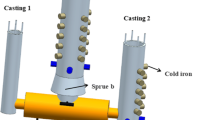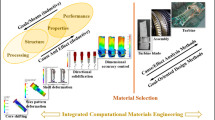Abstract
To study the coupling mechanism of shrinkage distribution and complex structures in the precision casting process of hollow turbine blades, the blade structure was simplified to a hollow thin-walled structure with resistance and non-resistance. Four different structures of casting and a casting system were designed. Based on the combination of numerical simulation and experimental measurement, the shrinkage distribution and shrinkage model of castings were established. The results show that the simulated and measured shrinkages have the same trend. Then, the structural parameters affecting shrinkage, including wall thickness, outer diameter, and unobstructed structure, were discussed. A mapping model based on a backpropagation (BP) neural network reflecting the relationship between structural parameters and shrinkage rate was constructed. According to the BP neural-network-based mapping model, the average deviations between the predicted and measured values of the transitional and normal sections are 5.8% and 2.4%, respectively, which improves the accuracy compared with existing research, indicating that the shrinkage model has a good performance in predicting shrinkage of the typical structure in hollow thin-walled castings.















Similar content being viewed by others
References
Panwisawas C, Gebelin JC, Reed RC (2013) Analysis of the mechanical deformation arising from investment casting of directionally solidified nickel-based superalloys. Mater Sci Technol 29(7):843–853
Wang JF, Bu K, Zhang D (2006) Optimization design of turbine blade mold cavity based on displacement field. Aeronautical Manufacturing Technology 49(10):73–75. (in Chinese)
Piwonka T, Wiest J (1998) Factors affecting investment casting pattern die dimensions. Incast USA 11(6):8–13
Zhang DH, Jiang RS, Li JL, Wang WH, Bu K (2010) Cavity optimization for investment casting die of turbine blade based on reverse engineering. Int J Adv Manuf Technol 48(9-12):839– 848
Ito M, Yamagishi T, Oshida Y (1996) Effect of selected physical properties of waxes on investments and casting shrinkage. The Journal of Prosthetic Dentistry 75(2):211–216
Ferreira JC, Mateus A (2003) A numerical and experimental study of fracture in RP stereo lithography patterns and ceramic shells for investment casting. Journal of Materials Processing Technology 134(1):135–144
Wu CL, Xu QY, Xiong JC, Li ZL, Li JR, Liu BC (2013) Numerical simulation of recrystallization process of nickel base single crystal superalloy. Acta Metall Sin(China) 49(5):523–529
Wang F, Li F, Han G, Sun B, Li YL (2018) Deformation study of ceramic mold with complex structure by dimensional measurement of Sn-Bi casting[C]. microelectronics systems education 423(1):1308–1320
Bu K, Tian GL, Qiu F, Zhao D., Zhang XD, Tian JW, Wang ZH, Hu J (2017) Research on the influence of structure parameters on the fractional shrinkage of wheel shape casting. Int J Adv Manuf Technol 93(5–8):2933–2942
Wang DH, He B, Liu SM, Liu CH, Fei L (2016) Dimensional shrinkage prediction based on displacement field in investment casting. Int J Adv Manuf Technol 85(1):201–208
Wang DH, Dong AP, Zhu GL, Shu D, Li F (2018) The propagation and accumulation of dimensional shrinkage for ring-to-ring structure in investment casting. Int J Adv Manuf Technol 96(1-3):623–629
Liu CH, Jin S, Lai XM, He B, Li F (2015) Influence of complex structure on the shrinkage of part in investment casting process. Int J Adv Manuf Technol 77(5-8):1191–1203
Campbell J (2011) Complete Casting Handbook: Metal Casting Processes, Techniques and Design. Butterworth-Heinemann
Kang J, Ma Q (2017) The role and impact of 3D printing technologies in casting. China Foundry 14(3):157–168
Chen LP, Wang YX, Peng LM, Fu PH, Jiang HY (2014) Study on the interfacial heat transfer coefficient between AZ91d magnesium alloy and silica sand. Exp Thermal Fluid Sci 54
Ge Y, Wang B, Nie J, Sun B (2016) A point cloud registration method combining enhanced particle swarm optimization and iterative closest point method. chinese control and decision conference 2810-2815
Tian G, Bu K, Zhao D., Zhang Y, Qiu F, Zhang X, Ren S (2018) A shrinkage prediction method of investment casting based on geometric parameters. Int J Adv Manuf Technol
Yu JY, Li Q, Tang J, Sun XD (2011) Predicting model on ultimate compressive strength of Al2O3-ZrO2 ceramic foam filter based on BP neural network. China Foundry 8(3):286–289
Manoochehri M, Kolahan F (2014) Integration of artificial neural network and simulated annealing algorithm to optimize deep drawing process. Int J Adv Manuf Technol 73(1):241–249
Zheng J, Wang Q, Zhao P, Wu C (2009) Optimization of highpressure die-casting process parameters using artificial neural network. Int J Adv Manuf Technol 44(7):667–674
Funding
This study was financially supported by the National Natural Science Foundation of China (grant number 51705440), the Fundamental Research Funds for the Central Universities XMU (grant number 20720180072), the Aeronautical Science Foundation of China (grant number 20170368001), the Shenzhen Fundamental Research Program (grant number JCYJ20170818141303656), and the Natural Science Foundation of Fujian Province, China (grant number 2019J01044).
Author information
Authors and Affiliations
Corresponding author
Additional information
Publisher’s note
Springer Nature remains neutral with regard to jurisdictional claims in published maps and institutional affiliations.
Rights and permissions
About this article
Cite this article
Dong, Y., Yan, W., Wu, Z. et al. Modeling of shrinkage characteristics during investment casting for typical structures of hollow turbine blades. Int J Adv Manuf Technol 110, 1249–1260 (2020). https://doi.org/10.1007/s00170-020-05861-2
Received:
Accepted:
Published:
Issue Date:
DOI: https://doi.org/10.1007/s00170-020-05861-2




